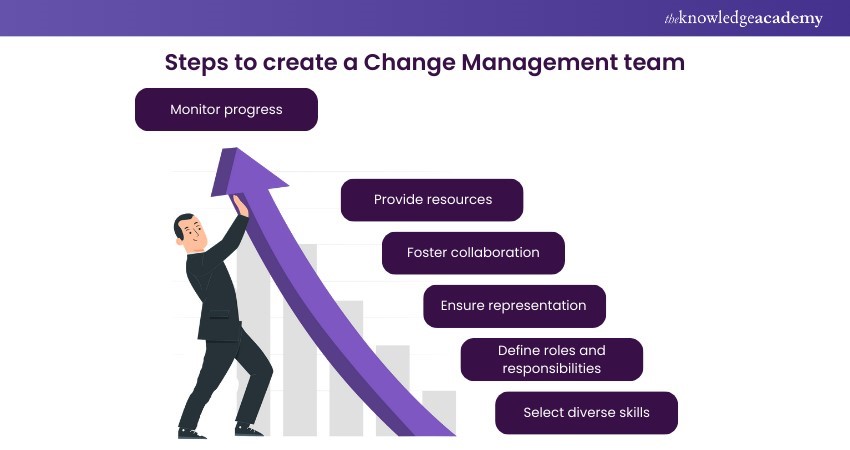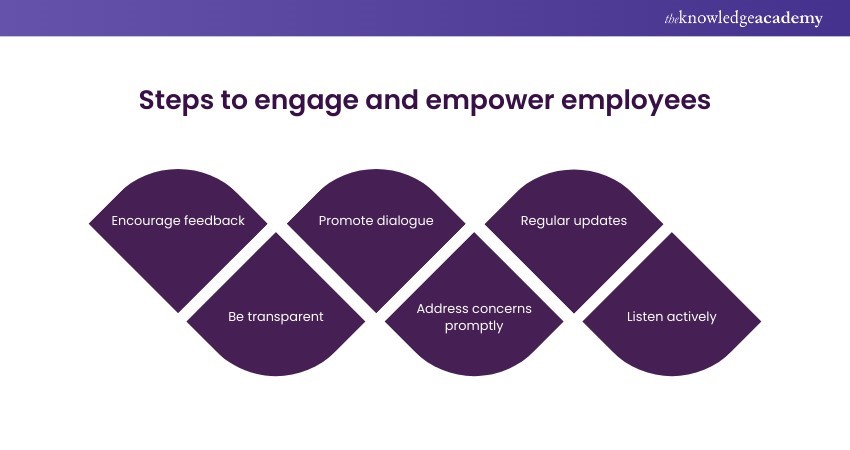We may not have the course you’re looking for. If you enquire or give us a call on +1 7204454674 and speak to our training experts, we may still be able to help with your training requirements.
Training Outcomes Within Your Budget!
We ensure quality, budget-alignment, and timely delivery by our expert instructors.

In today's dynamic business environment, organisations must continuously adapt to stay competitive and respond to market demands. This is where Change Management comes into play. There are numerous Change Management Best Practices available that can be implemented in enterprises for a smooth transition to change.
Change is a constant aspect of organisational growth and evolution. This blog unpacks the top 10 Change Management Best Practices for mastering change, ensuring organisations evolve and prosper.
Table of Contents
1) Best practices for effective Change Management
a) Define the need for change
b) Develop a clear vision
c) Create a Change Management team
d) Establish strong leadership
e) Plan and execute changes in phases
f) Provide training and support
g) Foster a culture of open communication
h) Engage and empower employees
i) Monitor progress
j) Celebrate the milestones
2) What is the best approach for implementing Change Management?
3) Conclusion
Top 10 Change Management Best Practices
Change management principles will simplify the process of picking out the best practises that can greatly help organizations.There are certain practices that organisations must embrace to create a productive and positive environment where employees feel empowered, engaged, and motivated to contribute to the change process. Here are the top 10 Change Management Best Practices:
Define the need for change
Understanding why change is necessary is the foundation of any successful Change Management strategy. It involves recognising the driving forces behind the need for change and communicating this need effectively to all stakeholders. Here are the steps to define the need for change:
a) Identify the drivers: Recognise the internal or external factors prompting the change.
b) Assess the current state: Understand where the organisation currently stands in relation to the desired change.
c) Clarify the impact: Determine how the change will affect different parts of the organisation.
d) Communicate the rationale: Ensure that the reasons for the change are clear to all stakeholders.
e) Create urgency: Establish a sense of importance around the need for change to motivate action.
f) Anticipate objections: Prepare for resistance by considering potential objections and planning appropriate responses.

Develop a clear vision
A clear vision provides direction and purpose for the change. It articulates what the future should look like and helps align the organisation’s efforts towards achieving this future state. Here are the steps to develop a clear vision:
a) Articulate the end goal: Define what success looks like post-change.
b) Align with organisational values: Ensure the vision is consistent with the company’s core values and mission.
c) Simplify the message: Create a simple, understandable, and memorable vision statement.
d) Inspire engagement: Craft a vision that excites and motivates stakeholders to participate.
e) Set measurable objectives: Include clear metrics to track progress towards the vision.
f) Communicate consistently: Regularly reinforce the vision through various communication channels.
Create a Change Management team
A dedicated Change Management team is responsible for planning, executing, and monitoring the change process. This team serves as the engine of the change initiative, ensuring that the change is managed effectively. Here are the steps to create a Change Management team:

a) Select diverse skills: Build a team with a mix of skills and experiences relevant to the change.
b) Define roles and responsibilities: Clearly outline each team member’s role in the change process.
c) Ensure representation: Include members from different levels and functions of the organisation.
d) Foster collaboration: Encourage open communication and teamwork within the group.
e) Provide resources: Allocate the necessary tools, time, and budget for the team to operate effectively.
f) Monitor progress: Set up mechanisms to track the team’s activities and the change initiative’s progress.
Establish strong leadership
Strong leadership is crucial for driving change. Leaders must be committed, visible, and active throughout the change process to guide and support their teams, ensuring the change is implemented smoothly and successfully. Here are the steps to establish strong leadership:
a) Lead by example: Leaders should embody the change they want to see in the organisation.
b) Maintain visibility: Leaders must be seen and actively involved in the change process.
c) Communicate openly: Keep lines of communication open and provide regular updates.
d) Support the team: Offer guidance and support to the Change Management team and affected employees.
e) Make informed decisions: Use data and feedback to make decisions that steer the change effort.
f) Encourage resilience: Promote a culture of adaptability and resilience within the organisation.
Plan and execute change in phases
Implementing change in a structured, phased approach allows for careful evaluation and adjustment, ensuring a smooth transition and successful adoption. Here are the steps to plan change in phases:
a) Start with a pilot: Test changes on a small scale before full implementation.
b) Set realistic timelines: Ensure each phase has achievable deadlines.
c) Assess phase outcomes: Evaluate the results before moving to the next phase.
d) Adjust plans as needed: Be flexible and make adjustments based on feedback.
e) Communicate phase transitions: Keep everyone informed as you move from one phase to another.
f) Ensure continuity: Make sure that each phase smoothly transitions into the next.
Upgrade your Change Management skills today with our Change Management Practitioner Course.
Provide training and support
Empowering employees through comprehensive training and robust support systems is crucial for the seamless integration of new processes. Here are the steps to provide training and support:
a) Offer comprehensive training: Equip employees with the knowledge to handle new processes.
b) Create support resources: Develop guides, FAQs, and help desks for ongoing assistance.
c) Tailor training to roles: Customise training based on the specific needs of different roles.
d) Update training materials: Keep resources current with the latest information.
e) Gather feedback on training: Use feedback to improve future training sessions.
f) Recognise learning curves: Allow time for employees to become proficient with changes.
Foster a culture of open communication
A culture that values open communication fosters an environment where feedback is welcomed, transparency is the norm, and dialogue drives innovation. Here are the steps to foster a culture of open communication:
a) Encourage feedback: Create channels for employees to share their thoughts and concerns.
b) Be transparent: Share information about the change process openly.
c) Promote dialogue: Encourage discussions between different levels of the organisation.
d) Address concerns promptly: Respond to feedback and concerns in a timely manner.
e) Regular updates: Keep everyone informed about progress and developments.
f) Listen actively: Show that management values employee input and takes it seriously.
Engage and empower employees
Engaging and empowering employees is a crucial aspect of Change Management. When employees are actively involved and feel a sense of ownership in the change process, they become invested in its success. Here are the steps to engage and empower employees:

a) Encourage feedback: Create channels for employees to share their thoughts and concerns.
b) Be transparent: Share information about the change process openly.
c) Promote dialogue: Encourage discussions between different levels of the organisation.
d) Address concerns promptly: Respond to feedback and concerns in a timely manner.
e) Regular updates: Keep everyone informed about progress and developments.
f) Listen actively: Show that management values employee input and takes it seriously.
Monitor progress
Regular monitoring and assessing progress against clear metrics are essential for staying on track and making informed adjustments to the change strategy. Here are the steps to monitor progress:
a) Set clear metrics: Define what success looks like and how it will be measured
b) Use tracking tools: Implement systems to monitor the change process
c) Review regularly: Schedule periodic check-ins to assess progress
d) Adjust strategies: Use data to inform necessary adjustments to the change plan
e) Report findings: Share progress reports with stakeholders
f) Learn from setbacks: Analyse any issues to improve future change initiatives
Celebrate the milestones
Celebrating milestones recognises achievements, boosts morale and maintains momentum toward continuous improvement and future goals. Here are the steps to celebrate the milestones:
a) Recognise achievements: Acknowledge when targets or phases are completed successfully.
b) Share success stories: Highlight positive outcomes and benefits realised from the change.
c) Reward teams: Offer incentives or celebrations for reaching milestones.
d) Reflect on the journey: Take time to look back on what has been accomplished.
e) Maintain momentum: Use celebrations to motivate and drive further change.
f) Plan for the future: Use milestones as opportunities to set new goals.
Acquire the skills to drive successful change initiatives in organisations – join our Change Management Foundation & Practitioner Training today!
What is the best approach for implementing Change Management?
The best approach for implementing Change Management depends on the nature of change and the organisation's structure. Here are some approaches:
a) Assessment and preparation: To start implementing change in an organisation, you have to first understand the current state of the organisation, the state it is in, and its future goals. After you have determined its state, now it’s time for you to start understanding the potential reactions and keeping in mind the current morale of the existing organisation’s culture.
b) Developing strategy: After you have established a clear vision for the change in the organisation, it is time to develop a strategy in such a way that aligns with the interests of the leadership as well as the stakeholders.
c) Execution of the change: To execute all the necessary changes, you must remember that you engage with all the stakeholders equally. Providing necessary training to the employees is also very crucial at this time. You will also get to know how to manage the resistance that might occur when you try to implement all the changes.
d) Review: It is very important that you review the change before it reaches any completion. This review helps you to understand what needs to be added, modified, or removed. The changes that are supposed to bring profit to the organisation are producing the intended results or not.
e) Integration and closure: Implementing changes in the organisation after properly reviewing the intended changes. Remember to engage simultaneously, as it helps the stakeholders, leadership, and employees understand that the changes being made are beneficial. Lastly, always document the processes you followed and the errors during the implementation. It will help you not to repeat the same mistakes the next time you want a change to be made.
Conclusion
Change management is a critical discipline that ensures successful transitions in organisations. We hope this blog has improved your understanding of the top 10 Change Management Best Practices, which help businesses effectively navigate change, engage employees, and drive positive outcomes.
Build a solid foundation in Change Management by registering for our Change Management Foundation Course now!
Frequently Asked Questions

The 7 Rs are a checklist to ensure thorough preparation for change requests, and they are listed below:
1) Who Raised the change?
2) What’s the Reason for it?
3) What Return is expected?
4) What Risks are involved?
5) Who is Responsible for implementation?
6) What Resources are needed?
7) What’s the Relationship with other changes?

The 7 Cs of Change Management are as follows:
1) Clarity in objectives
2) Communication of plans
3) Consistency in actions
4) Commitment from everyone
5) Courage to face challenges
6) Control over the process
7) Compassion towards those affected

The Knowledge Academy takes global learning to new heights, offering over 30,000 online courses across 490+ locations in 220 countries. This expansive reach ensures accessibility and convenience for learners worldwide.
Alongside our diverse Online Course Catalogue, encompassing 17 major categories, we go the extra mile by providing a plethora of free educational Online Resources like News updates, Blogs, videos, webinars, and interview questions. Tailoring learning experiences further, professionals can maximise value with customisable Course Bundles of TKA.

The Knowledge Academy’s Knowledge Pass, a prepaid voucher, adds another layer of flexibility, allowing course bookings over a 12-month period. Join us on a journey where education knows no bounds.

The Knowledge Academy offers various Change Management Certifications, including Change Management Foundation and Practitioner Courses. These courses cater to different skill levels, providing comprehensive insights into Change Management Plans.
Our Project Management Blogs cover a range of topics related to Change Management Certification, offering valuable resources, best practices, and industry insights. Whether you are a beginner or looking to advance your Change Management skills, The Knowledge Academy's diverse courses and informative blogs have you covered.
Upcoming Project Management Resources Batches & Dates
Date
 Change Management Foundation & Practitioner
Change Management Foundation & Practitioner
Mon 13th May 2024
Mon 22nd Jul 2024
Mon 23rd Sep 2024
Mon 4th Nov 2024







 Top Rated Course
Top Rated Course


 If you wish to make any changes to your course, please
If you wish to make any changes to your course, please


